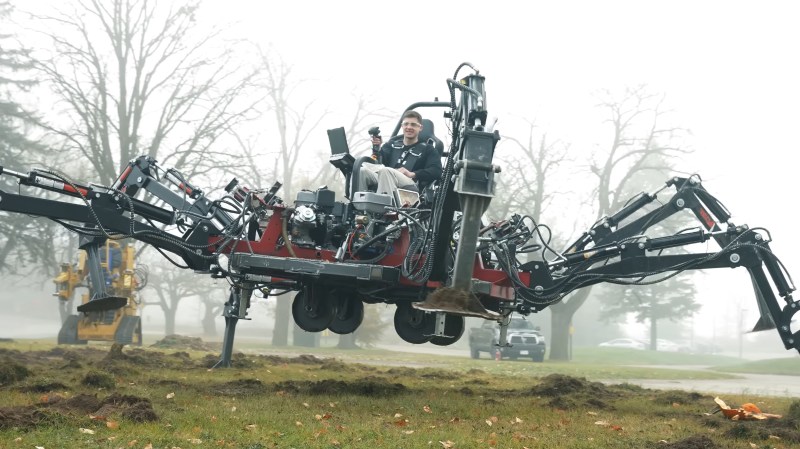Some projects start with a relatively simple idea that quickly turns into a bit of a nightmare when you get to the actual implementation. [Hacksmith Industries] found this to be the case when they decided to build a giant rideable hexapod, Megahex. [YouTube]
After seeing a video of a small excavator that could move itself small distances with its bucket, the team thought they could simply weld six of them together and hook them to a controller. What started as a three month project quickly spiraled into a year and a half of incremental improvements that gave them just enough hope to keep going forward. Given how many parts had to be swapped out before they got the mech walking, one might be tempted to call this Theseus’ Hexapod.
Despite all the issues getting to the final product, the Megahex is an impressive build. Forward motion and rotation on something with legs this massive is a truly impressive feat. Does the machine last long in this workable, epic state? Spoilers: no. But, the crew learned a lot and sometimes that’s still a good outcome from a project.
If you’re looking for more hexapod fun, checkout Stompy, another rideable hexapod, or Megapod, a significantly smaller 3D-printed machine.
















Add two more legs, four rocket launchers, and a fish… and you’ll have the beginnings of a Factorio Spidertron.
Needs a huge brain on top and a gatling gun like the doom boss
I was thinking about a large black orb with an eye, suspended below the intersection of the legs.
An interesting and very nice variant:
https://www.halledelamachine.fr/en/fiche-mecanique/the-spider/
https://www.qwant.com/?t=videos&q=lamachine+spectacle+araignee&o=0%3AJb5cYf66E10
https://www.francetvinfo.fr/pictures/mllHqL04Y8ATUCdd73-t55m1es8/fit-in/720x/filters:format(webp)/2019/04/12/araignee_machine_toulouse.jpg
I was thinking more like this:
https://m.youtube.com/watch?v=gIAi02ylD1s
B^)
The one in the Wil Smith movie Wild West was steam powered.
Came here to make the same reference. :D
I have even more respect for spiders now …
I don’t even want to know how much this cost.
That doesn’t stop me from wanting one a smaller scale one, with some amount of autonomy… or at least FPV
2020 hindsight I wonder if they would have ditched the off the shelf digger arms and started from scratch with rams + hydraulic actuators. Especially given experience gained doing the loader. 10/10 for trying anyway…
I kept wondering if they had run a finite element analysis on their computer models, assuming they had access to such software. That would have been really important to getting everything right like the hydraulic cylinder sizes, the pressures and flow rates needed, the pumps needed for that, etc.
I suspect they would have determined they’d need to build something from scratch, probably with 1 or 2 centralized ICEs providing more power with less weight, 1 or 2 hydraulic loops, along with cylinders and leg geometry sized for the task at hand.
That would totally violate the spirit of what they were trying to do, but as they said, legs are hard. It looks like they could have benefited from a bit more time working with the models before trying to build full scale.
I’m fairly certain that SolidWorks can do FEA, but I haven’t used that program since 2008 or so…
Would that not be arachrobophobia?
Why didn’t they use electric valves from the get go? Why go with servos when there are off the shelf solenoid actuated valves? That seems like a bad design choice from the beginning.
If you watched the video you would see they were using a self propelled backhoes for each arm, so they obviously reused the existing valve gear from the beginning. considering the project was ultimately abandoned it was the right choice to keep down cost.
Because they don’t know what they are doing.
On our previous mech build, our Aliens Powerloader, we got digital proportional valves sponsored by Bosch Rexroth, 12 of them at a cost 3k/e.
We’d need 24 for Megahex. Beside not being sponsored this time around, A) we couldn’t afford them because its a bootstrapped project and B) repourposing cheap manual proportional valves with RC servos is actually a pretty novel and affordable hack for turning any old hydraulic equipment remote controlled. Considering how well it worked all things considered, it was quite the achievement.
As for any of the other armchair engineers commenting about us not knowing what we’re doing, come back when you’ve built a mech (or two), because just by the numbers we are at default in the top 5 active companies in the world even trying to build mechs. 😉
Yeah! Tell ’em!
That was also my thought. But I thought, I am biased, as I design electronic controllers for hydraulic valves :-)
A rotating joint at the foot pad might reduce torque from the twist movements while moving
Reminds me of a prototype of a walking forest harvester from a company called Timberjack:
https://www.youtube.com/watch?v=CD2V8GFqk_Y
That is just an ant, he’s 2 legs short!
What a web of deceit you weave.
I was watching this video with my son yesterday. He was fascinated. A lengtly discussion about how to improve it better ensued.
So, even if the project didn’t turn out as you wanted, I would argue that it was a success. Thanks for the inspirtation!
Glad you were able to have a good discussion! We can learn a lot more sometimes from what doesn’t work than when things go perfectly, it seems!